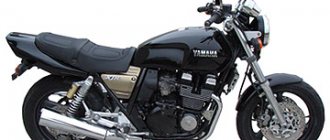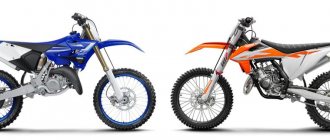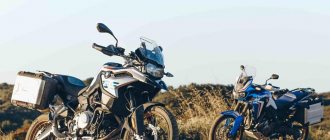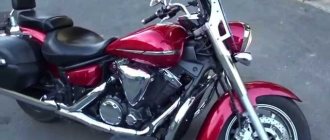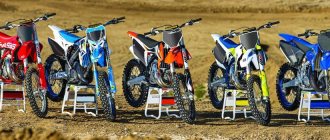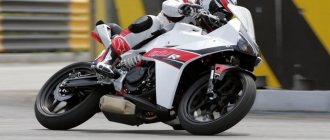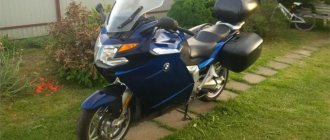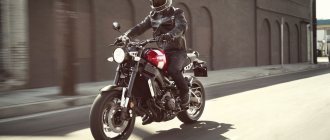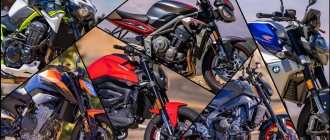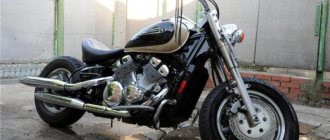This is a classic road bike that is perfect for old school motorcycle enthusiasts. Unlike many other models of this kind, the Yamaha HZHR 1300 is still being produced, which pleases motorcyclists who are tired of endless naked bikes and similar road bikes.
This is a fairly large car, and a powerful one at that. It is definitely not suitable for a beginner, but an experienced rider will feel comfortable. The motorcycle has a rich history of changes, which has allowed it to stay afloat for almost twenty years.
Dimensions and weight
Good motorcycle dynamics are impossible if the dimensions do not match the filling. The XJR 1300 is fine with this. Although the motorcycle is large for its class, its dry weight is only 224 kg. The volume of the gas tank here is 21 liters, and not to say that this is a lot, because the average fuel consumption here is from 7 liters to 11 liters per hundred kilometers.
Advantages
The Yamaha XJR 1200 is a bundle of energy, a hurricane, created for speeds that were prohibitive for those times. It was initially capable of flying up to 240 km/h, despite the fact that the bike was released, for a minute, back in 1999.
Despite its impressive dimensions and decent weight, the motorcycle is easy to control, it is as comfortable as possible, thanks to a comfortable, moderately soft saddle and a soft suspension that absorbs road unevenness. To this we can add the smooth traction of the engine, an excellent 5-speed gearbox and quite decent brakes, borrowed from the 1200 predecessor.
Chassis and brakes
The brakes were taken from the 1200 model; They are certainly good, but there is nothing outstanding about them, and the XJR 1300 is not worth driving at full speed. The suspension has undergone minor changes. For example, the telescopic fork inherited from its predecessor has been modified.
In general, the 1200 and 1300 are very similar in appearance. This is not surprising given that one motorcycle has essentially been converted into another. Like its predecessor, the XJR 1300 is a typical road classic in its appearance, and a classic of the 90s. For this reason, it looks very extravagant compared to many bikes with a more modern exterior.
Review of the Yamaha XJR 1300 motorcycle
I bought it in 2007 through Auto.ru, the mileage was about 3000 km, and real. The mot is practically naked - small arcs and that's it. Immediately installed the central case and Givi glass, Starline alarm system. I had this Givi case on the 400th Phaser, and now it will serve here. A little later, I had to clean the rear brake cylinder and replace the rear pads, as they had become sour and were slowing down all the time. Heated grips from moto.ru Engine oil Motorex 15w50 from the same place. I replaced it before winter - I thought I’d drive all winter, naive)))
In winter it was parked in a warm garage and would be started from time to time to warm up. Opened the 2008 season with a mileage of 6900 km in April. I didn’t do anything before the season - I just installed the mounts for the side panniers; the panniers themselves will come later.
On June 02, 2008, I replaced the battery with a Platinum YT14B-BS, purchased from Moto.ru for 3,900 rubles. The old gel battery died and I had to start the heavy motorcycle all the time from the pushrod in 2nd gear. And the ground clearance of the motorcycle is quite low. On the one hand, this is very good - an excellent road bike! But jumping off curbs will no longer work. So one day I got stuck on a curb with a dead battery - I wanted to shorten the path and ended up hanging. With difficulty, we pushed him out together with a passerby.
The 2009 season opened in May, at 12,400 km I changed the rear brake pads. At 14,000 km, I tightened the chain. They helped me at a nearby car service for 100 rubles by tightening the nuts 2 turns. By this time, the brake light bracket at the place where the trunk was attached had cracked—it needed to be fixed. The rear brake frog is also stuck - it is in a very dirty place and needs to be cleaned.
The bracket was removed and welded semi-automatically. The metal is worthless, high carbon. The frog is plastic, there was no need to clean it - just unscrew it half a turn and everything works again. You can use sealant to prevent it from moving. I did static balancing of the front wheel on Kashirka. The rear one is also worn out - I punctured it twice this season - it became thin in the middle, and there are already two fungi in the tire.
Of course, the first thing you feel when you sit on this motorcycle is the feeling of enormous power. You just turn the throttle a little, and the motorcycle just flies forward. You can accelerate to third gear while keeping the front wheel in the air! And this is with a motorcycle curb weight of 250 kg. The number of motorcycles that can reach 0-100 km/h in three seconds can be counted on one hand. Among them is the XJR1300!
A little history. The XJR series has been produced by Yamaha since 1995. This is a further development of the well-known XJ series, which has been produced since 1984. In 1999, the engine capacity was increased to 1251 cm3, and now it is the largest air vent in the world. Since 1999, engine cylinders have been coated with a composite chrome composition to improve performance, and the pistons have been forged.
Carburetors are equipped with a TPS sensor. It adjusts the ignition timing for each throttle position. Thanks to it, the engine picks up speed faster and does not choke when the throttle is opened suddenly.
Now let's start the inspection. A large headlight forces drivers of slow-moving cars to look in the rearview mirror early. The engine from the side looks like a small engineering factory. Wide tires and impressive mufflers give the impression of solidity. Well, the composition is completed by a stylish rear light. All this together gives the motorcycle a spectacular muscular look.
The mirrors are spaced quite wide, and rear visibility is excellent. At idle, the image in them vibrates slightly, but after one and a half thousand revolutions the vibrations disappear completely.
The dashboard is convenient and informative. The speedometer is flattering, calibrated to 260 km. There is a fuel gauge that works surprisingly accurately. This is a very important device that allows you to refuel in advance, and not lose traction somewhere when overtaking, frantically trying to switch to reserve. There are daily and total mileage meters.
The large, wide saddle provides plenty of room for both rider and passenger. The fit is classic and very comfortable. Moreover, the driver’s position is not rigidly fixed, and you can move back and forth, which is simply necessary on long trips. Under the saddle there is a large glove box with clever fastenings. When traveling, I put a full set of tools, a tire repair kit, a package of cold welding, a first aid kit, and lubricant there. There is also an alarm there.
One cool feature is that the generator has slots in the cover, probably made for cooling. Dirt does not get there from the road, but it is somehow strange to observe the windings of the generator, which are usually hermetically sealed.
Handling is quite good, wide tires and adjustable suspension provide excellent stability in all modes. Riding “over 200” does not cause any problems, except for the fear of being torn from the motorcycle by the air flow. True, when cornering at speeds above 160 km/h, the tail of the motorcycle begins to wag noticeably. This can be eliminated by replacing the rear pendulum and steering column bearings with tuning ones (this defect has been corrected on 2001 models). The maximum speed according to the speedometer is 250 km/h, the real speed is 235 km/h.
I set the suspension settings to maximum stiffness because I weigh about a hundred pounds and often travel with a passenger and cargo in the trunk. With this setting, the rear shock absorbers never work all the way, but the front shock absorbers would benefit from a little more stiffness, or even better, travel. Nevertheless, any potholes are skipped over without effort and there is practically no feedback on the steering wheel.
It takes a lot of effort to get a motorcycle into a turn. On normal roads, this is not a disadvantage for me, but an advantage, since it allows you to completely relax and even lie down on the tank on a straight road. Nevertheless, two hundred kilometers a day along the continuous Crimean serpentine road with endless “mother-in-law’s tongues” is a task quite within our capabilities. Although my hands were very tired. And of course, a monoshock absorber at the rear would be nice, but that comes at a cost of style.
To my regret, the weight distribution of the motorcycle practically does not allow doing stoppies (rising up on the front wheel during heavy braking). If you press the front brake, the front wheel simply slips. But nothing bad will happen (unless, of course, you do this while turning), the motorcycle will not lose stability and will continue to move in a straight line, but with a locked wheel.
The wonderful Michelin Macadam 90x tires add to the feeling of reliability. When returning from Yalta we were caught in a heavy downpour. Such that cars simply stood on the side of the road, and motorcycles were almost crawling along the road. Only due to the front tire with a double groove for draining water in the middle, it was possible to simply not notice the water and drive at 120 km/h! The disadvantage of this rubber is the appearance of “teeth” on the tread and, as a result, vibrations on the steering wheel after a certain mileage. Now people are switching en masse to Bridgestone BT 020.
At high speeds, the motorcycle rides as if on rails, but at low speeds it is better not to drop the steering wheel, because the geometry of the motorcycle causes strong vibrations of the steering wheel with increasing amplitude. By the way, this effect is present on many motorcycles. I note that on new tires and with tuning bearings the effect disappears.
Due to the low ground clearance (13 cm), on bad roads the motorcycle sometimes hits bumps with the center stand. This does not cause any damage, so I don’t consider this a disadvantage, but the very presence of a central step is a big plus.
By the way, after installing the roll bars, the motorcycle began to scrape the bolts securing them in turns. This leads to the motorcycle moving out of the turn by half a meter to a meter. Of course, this only manifests itself when you push the bike to the maximum, but it is precisely at this moment that it is most dangerous. So the fastening of the arcs will have to be reworked.
There are two brake discs on the front wheel. The powerful 4-piston calipers, borrowed from the R1, work very smoothly and efficiently. There is one disc on the rear wheel. However, the rear brake causes the wheel to skid at the slightest effort. Therefore, it must be used extremely carefully to avoid highside.
The soft hydraulic clutch allows you to start without the slightest effort and change gears, which are switched on very clearly. Neutral is located without problems, in addition, I was pleased with the ability to engage 2nd gear from neutral while moving and without re-gearing.
The chain drive adds sportiness. It’s not for nothing that owners of motorcycles with a cardan who tune their motorcycles replace the cardan with a chain. Modern technologies for manufacturing chains make it possible to extend their service life to 30,000 km or more (in my harsh operating conditions, the chain runs 17,000-20,000 km). And the myth about the ultra-reliability of the cardan is just a myth. Even on touring bimmers, the universal joint sometimes falls apart. And if a broken chain is easy to repair on the road, then try doing it with a cardan. Of course, the cardan lasts longer on average and does not require maintenance. But these benefits are not worth the 5-10% loss of torque.
A large tank (21 l) allows you to travel up to 400 km without stopping (in reality, I fill up every 250 km). Fuel consumption, however, is not small. When driving 160 km/h it reaches 9l/100km. But when driving 50 km/h, the consumption is only 5 l/100 km.
While traveling around the CIS and Asia, another strong trump card of the motorcycle emerged - the ability to refuel with gasoline of any quality. In fact, the low compression ratio means you don't have to worry about the octane number. And the air engine has an operating temperature much higher than that of water-cooled engines, so that all gasoline impurities are successfully burned directly in the cylinders, without frightening others with shots from the muffler. Another undeniable advantage of the inline four is easy maintenance. Free access to spark plugs and carburetors.
When changing oil, keep in mind that synthetics can cause clutch slipping and accelerated wear. Therefore, if you feel sorry for the clutch, it is better to use semi-synthetic (aka mineral water with additives).
The problem with the XJR is its weak subframe. When driving with a passenger and a rear case on a bad road, it usually breaks. To be fair, the same problem occurred on both the Hayabusa and the X4. The guys from NAMI strengthened the subframe with metal gussets. This design has successfully passed off-road testing in the Gobi Desert.
